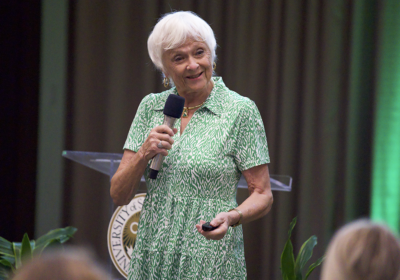USF earns $2.6 million in performance funding
USF took home the biggest portion of the Florida Board of Governor’s $20 million in performance-based funding last week, bringing in $2.6 million after topping other schools — including the state’s two recognized preeminent universities — on a list of three metrics.
Though the small bonus comes at a time when the university is making spending reductions, USF Provost Ralph Wilcox said the university is appreciative but not surprised by the gains it made, as it has been preparing for performance-based funding for more than a decade.
While state funding for public universities in Florida had previously been determined solely by enrollment — a large reason behind why Florida has five of the largest public institutions, Wilcox said — performance-based funding and monitoring metrics have been on USF’s radar since its strategic plan in 2004.
“The concern we had was that we weren’t able to adequately support our students,” Wilcox said. “For the past six or seven years, USF has really been quite disciplined in terms of the numbers of students we enroll. … We’ve shifted away from enrollment growth, particularly on the Tampa campus and more toward student success.”
This year, the $20 million was allocated based on three metrics selected by the Board of Governors — percentage of graduates employed or pursuing further education one year after graduation, median average full-time wages of undergraduates employed one year after graduation and average cost to university per undergraduate.
USF tied with UCF for having 69 percent of graduates employed or pursuing further education one year after graduation, according to data collected from the National Student Clearinghouse. UF and FSU had 63 percent of graduates in this category.
The university also topped UF and FSU for median full-time wages for those employed one year after graduation at $33,466.
USF provided the second lowest cost for education, with a cost of about $23,276 per degree.
But this last metric, Wilcox said, is “a mixed blessing of sorts.”
“Yes, it allows us to keep the cost down, but we know there’s a delicate balance between producing a world-class, competitive education … that takes some investment,” he said.
Next year, the board plans to increase the total amount of money allocated based on performance-based metrics to $50 million and use 10 metrics instead of three, eight applied to all universities, one picked by the Board for an individual university and one picked by each university’s Board of Trustees for itself.
Wilcox said USF’s Board of Trustees will likely decide what metric it will use by its next meeting, but that it is likely it will pertain to research.
Though the increased number of metrics used include six-year graduation rates, a statistic in which USF lags behind some of the other Florida institutions, it also includes measures for the university’s accessibility rate based on Pell Grant recipients and science, technology, engineering and mathematics graduates. Wilcox said the university prefers the greater number of metrics used.
“It captures more broadly the priorities of the University of South Florida and what we believe should be the priorities of the State University System,” he said.
Board of Governors member Tom Kuntz said he was in favor of increasing the number of metrics, but said he hopes “room for common sense” remains.
Though performance-based funding can be expected to stay, Wilcox said the university cannot count on the $2.6 million as being a recurring source of funding as they may receive a different amount in future years, and thus cannot use the money toward recurring expenses, such as hiring new faculty or other long-term investments.
Performance-based metrics, Wilcox said, are a better overall measure of USF than the metrics used for preeminence, which include endowments, freshman academic profiles and rankings for research expenditures.
“We ought to be gauging performance by recognized national metrics, not metrics that are recognized for one reason or another by elected officials here in the state of Florida,” he said. “It’s in the best interest of students and others at the university to know their institution is competing with the very best — both public and private — universities across the country. … We looked at the 60 American AAU universities to see how many of them would meet the Florida preeminence benchmark and only three did — Princeton didn’t, Berkeley didn’t, Michigan didn’t. The only three were the University of Florida, UCLA and Harvard that met the Florida preeminence benchmarks. That should tell you something.”







